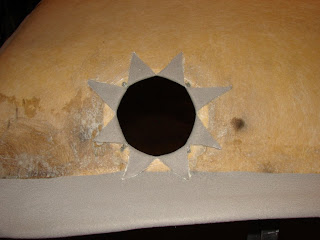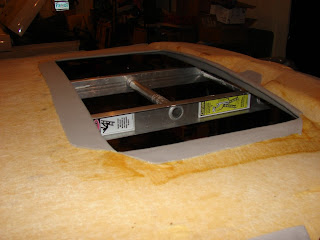I caught a break on Wednesday. The temperature was above 70 (F) degrees. That may not seem like much of a break. If you knew that last Tuesday I pulled the sagging headliner off my overhead with the thought I would replace it after I was done running my mom to her doctor appointments. What I didn’t plan for was the application temperature for the spray glue.
Yes, spray glue has an optimum temperature with a minimum and maximum temperature use range. 70(F) is the lowest you should attempt to use their product. As the temperature was a pleasant and hovering in the mid 50s(F) that day I thought I’d be fine. But after reading the side, I thought I should probably call the information line. The lady on the other end of the line, said, “seventy, seventy degrees”. Well that was disappointing.
So I went on with my sanding of the old glue away from the overhead and generally cleaned up the surface in anticipation of NEXT MARCH! when I know the temperature would creep above 70 degrees. I used some 60 grit sandpaper and a foam sanding block. It’s light sanding, just enough to remove the glue. It is apparent that this will be the last swap with this fiberglass overhead. The fiberglass layers are starting to separate and will either need to be repaired or replaced.

So I rolled out the new headliner material that I bought from Gipson’s Trim in Oklahoma City. This place is a throw back to the old warehouse style shops in the olden days. Every thing about this place is retro. They still hand write receipts. You can see the rolls of materials behind them in the dusty and unkempt shop. So I told the counter man my application and he suggested the thin foam fabric due to the sunroof, and pointed me to the samples board, “Just match it up the best you can.” So I did, selecting W1913. I am mostly unable to distinguish one shade from another, my internal color wheel doesn’t work all that well.
I purchased three yards and two cans of glue. I remembered after I got home and cut the fabric that I made this same mistake last time. I needed 3.5 yards, factoring in the fabric for the sunroof cover and a little over two cans of glue. I had two extra cans of glue so I was good there, but will need to buy another yard (half yard if they will sell that little) for the sunroof.
I laid out the fabric and decided to use the “glue a foot, stick a foot” method. My friend EGD said that is how he had done it before. The last time I did the job I glued a few feet and tried to stick it with mixed results.
I am now ready to offer the secret to getting the liner into all the corners. I didn’t do this, and only came up with the solution AFTER I finished gluing. Get some weights in bags, place them on the fabric in the corners to insure they fabric meets the contours and stays in place as you stretch and match the fabric to the contours. I have a few places that the fabric after stretching it here and there pulled loose from the headliner overhead. I may try a injection technique I’m dreaming up in a lame attempt to fix my mistakes. A bag full of shot might be too heavy, while a small bag full of beans might be too lightweight. I think some five pound leg weights, the kind in bags might work. More on that if I try it.
The last time I did this project I attempted to cut the fabric “to fit” the openings. But after I saw what it was doing I decided to try a different technique. The first time I did the project I used masking tape to hold the fabric. It worked well, and was still in place when I removed the old fabric this time. On this headliner swap I decided to use glue and glue the fabric on the underside.
I also cut all the holes using a pie pattern which I hope will provide good results.
It produces a star pattern when you glue it back.
I used this or a similar method in all the openings. The sunroof, I cut to the corners and then cut out the middle to within 3 inches of the edge. The same with the front dome light opening.
You can see my multi-function ladder which transforms like a freakin’ Transformer in to all kids of forms. This is the scaffold configuration which made a good surface for me to work on.
So with that, the temperature was dropping each minute so I was in a hurry. It shows in my work. Pro tip: Avoid being in a hurry and take your time. It will result in a much better product when you are done. Like EGD said while checking out my work at our Thanksgiving feast, “Just think, a few more times and you will be pretty good at that.” Maybe so, maybe so.
Thanks for reading and Happy Rovering.






